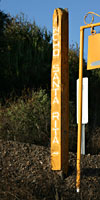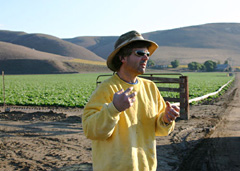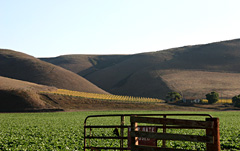Santa Rita Hills AVA
A
pictorial essay of California's newest 'hotbed' for Pinot Noir
by
Eric Anderson
(excerpted from Vol.11 No.5, Journal
du Vin, November 2003.)
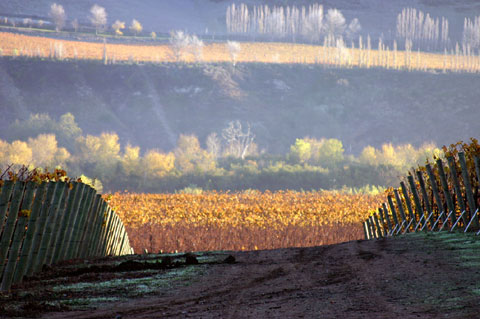 |
|
The
Fiddlestix Vineyard glistens in the early morning sun
|
Established
in 2001, the Santa Rita Hills AVA is actually a sub-appellation
of the Santa Ynez Valley AVA. At about 48 square miles in
size, it occupies slightly over 25% of the western-most portion
of the larger Santa Ynez appellation.
The
geography of this part of California is quite unique - the
region is the only area on the Pacific Coast of North America
with transverse, or east to west, mountain ranges. Adding
further to the distinction of the Santa Rita Hills AVA, an
ocean fog penetrates up to, and often past, the eastern end
of the appellation, just outside of Buellton.
Although
the Santa Rita Hills AVA is naturally cool and windy with
more of a maritime climate than the Santa Ynez Valley, the
fog adds an additional cooling element to the local vineyards.
This permits lower temperatures for a longer duration of time,
which in turn allows a longer hang time for the fruit - both
of which are advantageous for the Burgundian varietals of
Pinot Noir and Chardonnay.
|
|
|
|
Top:
Peter Cargasacchi. Below: Cargasacchi Vineyard,
nestled in a hillside
|
|
|
| Although
the Santa Rita Hills name would appear to have been embraced
by all the wine-loving population, as well as all of the
necessary AFT authorities, there has been one long-standing
issue with the name. The source of contention comes from
an unusual place, the Santa Rita winery of Chile. Ironically,
they feel that the similar name will mislead wine buyers.
An interim solution to litigation was to change the spelling
of the AVA to "Sta. Rita Hills." |
|
Bordered
by the Purisima Hills to the north, and the Santa Rosa Hills
to the south, there are in a sense, two valleys here, separated
by the namesake Santa Rita Hills, which run like an east-west
spine between them. While the soils of the two areas differ
somewhat (gravely and loamy in the south; sandy in the north),
the climate remains nearly identical in both - cold and windy.
Two major east-west roads pass through the AVA, Santa Rosa
Road on the south and Hwy 246 on the north. Both lead to Lompoc,
which has quickly become the 'de facto' wine capitol of the
AVA. The effect of all this attention has meant that rather
than becoming synonymous with "Santa Barbara Wine Country,"
the Santa Rita Hills AVA has instead become an entity in its
own right. Well, that is up to a point.
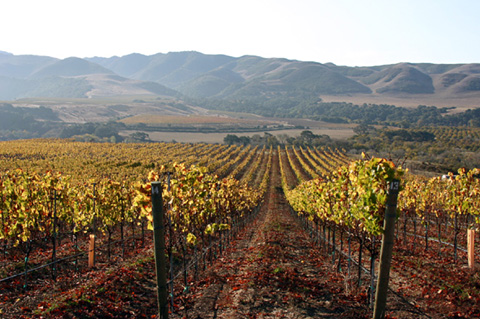 |
| Rick
Longoria's Fe Ciega (Blind Faith) Vineyard, with Sanford's
Rancho La Viña in the distance |
|
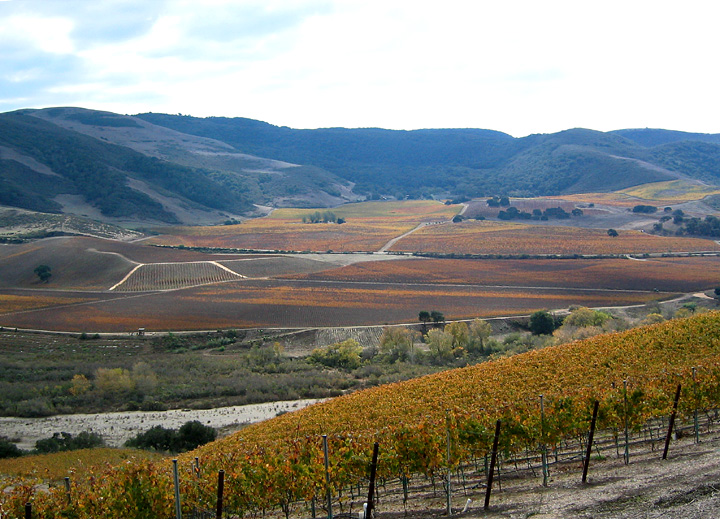 |
| Sea
Smoke Vineyards (foreground) march down the slope to the
dry Santa Ynez River bed. Just past the chapparal and
access road is Fiddlestix Vineyards. Beyond Santa Rosa
Road (middle of photo), lies the Sanford & Benedict
Vineyard, and La Rinconada Vineyard (background, far right) |
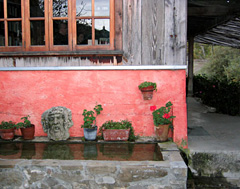 |
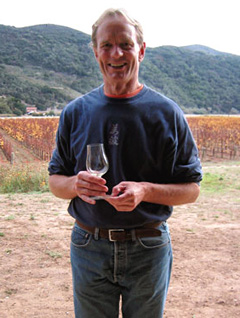 |
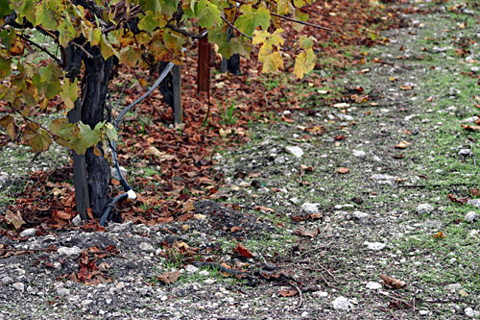 |
| Above:
the "chert" soil of Sanford & Benedict Vineyard.
Upper right: small fountain at Sanford Tasting
Room. Right: Richard Sanford |
|
There are over twenty vineyards here, most of them specializing
in Pinot Noir and/or Chardonnay, with a few acres planted
to Syrah, Pinot Blanc, some Pinot Gris, and even some
Dornfelder. Currently, the majority of vineyards are
planted on the southern edge of the appellation, south
of the Santa Rita Hills, on both sides of Santa Rosa
Road. Just to the north of Santa Rosa Road lies the
Santa Ynez River, and its benchlands.
This
particular area off Santa Rosa Road is rightly considered
the birthplace of the appellation. It was here in 1971
that Richard Sanford and Michael Benedict planted their
seminal eponymous vineyard with Pinot Noir and Chardonnay.
More than thirty years later, the area has become a
hotbed for California Pinot Noir.
|
|
|
|
|
Copyright
© 1993 - 2004, Eric Anderson -
All rights reserved
No original material may be reproduced without written consent
Mail & Comments
- Eric Anderson
|
|
|
|

|
|
|



